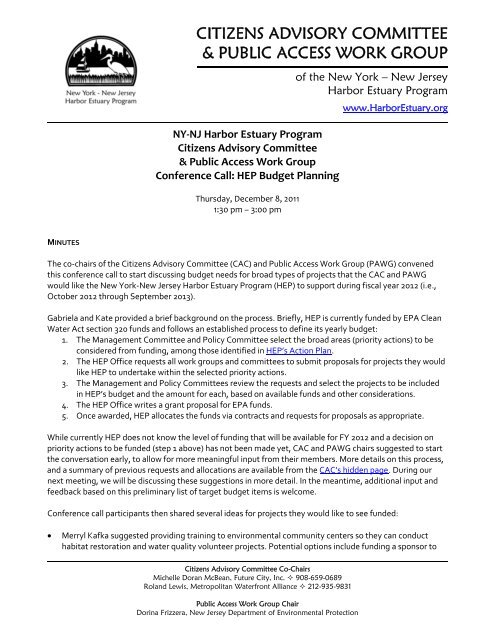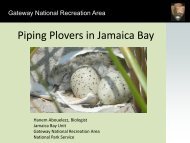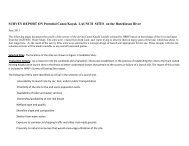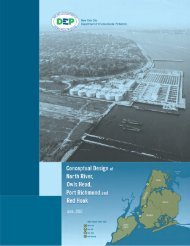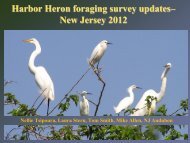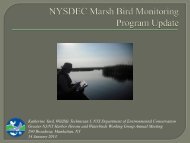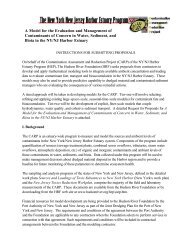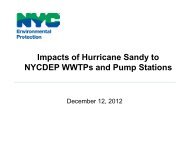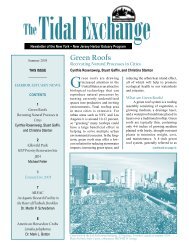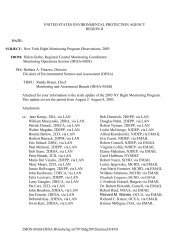cac-pawg-11dec8 .pdf - New York-New Jersey Harbor Estuary ...
cac-pawg-11dec8 .pdf - New York-New Jersey Harbor Estuary ...
cac-pawg-11dec8 .pdf - New York-New Jersey Harbor Estuary ...
You also want an ePaper? Increase the reach of your titles
YUMPU automatically turns print PDFs into web optimized ePapers that Google loves.
CITIZENS ADVISORY COMMITTEE& PUBLIC ACCESS WORK GROUPNY‐NJ <strong>Harbor</strong> <strong>Estuary</strong> ProgramCitizens Advisory Committee& Public Access Work GroupConference Call: HEP Budget PlanningThursday, December 8, 20111:30 pm – 3:00 pmof the <strong>New</strong> <strong>York</strong> – <strong>New</strong> <strong>Jersey</strong><strong>Harbor</strong> <strong>Estuary</strong> Programwww.<strong>Harbor</strong><strong>Estuary</strong>.orgMINUTESThe co‐chairs of the Citizens Advisory Committee (CAC) and Public Access Work Group (PAWG) convenedthis conference call to start discussing budget needs for broad types of projects that the CAC and PAWGwould like the <strong>New</strong> <strong>York</strong>‐<strong>New</strong> <strong>Jersey</strong> <strong>Harbor</strong> <strong>Estuary</strong> Program (HEP) to support during fiscal year 2012 (i.e.,October 2012 through September 2013).Gabriela and Kate provided a brief background on the process. Briefly, HEP is currently funded by EPA CleanWater Act section 320 funds and follows an established process to define its yearly budget:1. The Management Committee and Policy Committee select the broad areas (priority actions) to beconsidered from funding, among those identified in HEP’s Action Plan.2. The HEP Office requests all work groups and committees to submit proposals for projects they wouldlike HEP to undertake within the selected priority actions.3. The Management and Policy Committees review the requests and select the projects to be includedin HEP’s budget and the amount for each, based on available funds and other considerations.4. The HEP Office writes a grant proposal for EPA funds.5. Once awarded, HEP allocates the funds via contracts and requests for proposals as appropriate.While currently HEP does not know the level of funding that will be available for FY 2012 and a decision onpriority actions to be funded (step 1 above) has not been made yet, CAC and PAWG chairs suggested to startthe conversation early, to allow for more meaningful input from their members. More details on this process,and a summary of previous requests and allocations are available from the CAC’s hidden page. During ournext meeting, we will be discussing these suggestions in more detail. In the meantime, additional input andfeedback based on this preliminary list of target budget items is welcome.Conference call participants then shared several ideas for projects they would like to see funded:• Merryl Kafka suggested providing training to environmental community centers so they can conducthabitat restoration and water quality volunteer projects. Potential options include funding a sponsor toCitizens Advisory Committee Co-ChairsMichelle Doran McBean, Future City, Inc. 908-659-0689Roland Lewis, Metropolitan Waterfront Alliance 212-935-9831Public Access Work Group ChairDorina Frizzera, <strong>New</strong> <strong>Jersey</strong> Department of Environmental Protection
work with Sea Grant or others to develop and carry out the training, or providing funds for a seminar (HEPsupported a Community Water Quality training session at Stevens Institute several years ago). Otherspointed out that a goal and plan for how the data will be used is important. There may be existingopportunities to provide similar training, support, or coordination, in partnership with experts from EPARegion 2. The HEP office will communicate with EPA Region 2 to get a sense of existing support for theseefforts, and how HEP might play a role.• Bart Chezar proposed providing fellowships for a graduate student to conduct research. Michelle notedthat there are already other programs offering fellowships, such as the Hudson River Foundation.• Rob Buchanan had two suggestions:1) Support citizen water quality monitoring (not training) to empower community groups to be activelyengaged in water quality issues. While it should not be a deterrent, it was noted that any data collectionefforts funded by HEP need to develop a Quality Assurance Project Plan (QAPP) to document how thedata will be collected and its quality ensured. EPA Region 2 (NY and NJ) has staff dedicated to givingtechnical and QAPP development advice for community organizations. Dan Mundy mentioned anotherapproach: Jamaica Bay Eco Watchers worked with the <strong>New</strong> <strong>York</strong> City Department of EnvironmentalProtection (NYCDEP) so the agency would install monitoring devices at several locations—the data arepublicly available online in real time. Maggie Flanagan pointed out that there is a risk of underfundingthese efforts because monitoring equipment can be expensive. Nick Tufaro suggested that there shouldbe some common metrics for these efforts so the data collected can be much more powerful and useful,for example, to identify anomalies. Dorina Frizerra suggested that it would be good to frame the focus oncitizen water quality monitoring as an adoption/stewardship of a particular site.2) Support citizen mapping, so that the stewardship and perspectives of many groups are fostered.• Roland Lewis inquired about the possibility of funding Metropolitan Waterfront Alliance’s City of Waterevent. While it was acknowledged that this is a great and highly visible event, participants expressed apreference for funding small groups to build their capacity to attend the event. Roland also suggestedthat funds could go so support one of the satellite locations outside of Governors Island.• Bart Chezar suggested a workshop to improve the accessibility and interpretation of water quality data.• Maggie Flanagan expressed interest in continued funding to work on fish advisory issues. Dorinacommented that she did not think this was a good use for HEP funds.• Harvey Morginstin proposed grants to develop designs for specific public access sites. This may be donethrough the PAWG (or, in some cases, the Restoration Work group) as has been done in the past, such aswith HEP’s 2011 grant cycle, which included a funding category for new public access site development.Or, there may be new ways to build on this funding area.• There was some discussion on the amount of public monies spent on port development vs. restoration,both historically and currently. Rob Buchanan wondered if HEP could empower local groups to advocatefor more funds spent on restoration rather than development. However, it was pointed out that HEPfunds cannot fund direct lobbying or advo<strong>cac</strong>y efforts, but it can fund education and outreach. MerrylKafka noted that HEP is trying to educate public officials and Bob Nyman added that HEP would attendthe monthly meeting of Monmouth County mayors on December 13 and intends to attend other countymeetings in 2012. Nick Tufaro suggested putting together educational materials for municipal officials—the idea was generally well received.In order to facilitate the planning process, CAC members and attendees were asked to submit their ideas inwriting (whether or not they had been expressed during the call) by filling out the feedback form that hadbeen circulated prior to the meeting.Announcements2
Merryl Kafka mentioned that she writes a blog on educational updates and asked everyone to submit ideas toher, so she can help spread the word on the good work being done in our region. Merryl’s blog can beaccessed at http://educationupdate.com/merrylkafka/blog/ where there is also a link to contact her.Kate Boicourt reminded everybody to also consider sharing any estuary‐related news and events with HEP forinclusion in the e‐newsletter.Roland invited everyone to Metropolitan Waterfront Alliance’s holiday party, held that same afternoon at theSeaport Museum.Dorina mentioned a “Save the Date” for the June 8 th , 2012 Sacred Waters Honor Journey, a voyage fromrivers to sea to promote stewardship of waters across the world. She suggested that this could be a goodopportunity for our Public Access/boating partners to join in. More information can be found online at:http://honorjourney.org/ATTENDEESAlyson Beha, <strong>New</strong> <strong>York</strong>ers for ParksKate Boicourt, NY‐NJ <strong>Harbor</strong> <strong>Estuary</strong> ProgramNancy Brous, NYC Water Trail AssociationRob Buchanan, Village Community BoathouseBart Chezar, Gowanus Dredgers Canoe ClubAlan Cohn, NY City Department of Environmental ProtectionMeredith Comi, NY/NJ BaykeeperMichelle Doran McBean, Future City, Inc.Maggie FlanaganDorina Frizzera, NJDEP Coastal Management ProgramMerryl Kafka, NY State Marine Education AssociationAmy Kline, Friends of Brook ParkRoland Lewis, Metropolitan Waterfront AllianceHarvey Morginstin, Passaic River Boat ClubDan Mundy, Jamaica Bay Eco WatchersGabriela Munoz, NY‐NJ <strong>Harbor</strong> <strong>Estuary</strong> ProgramDenise Nickel, Middlesex County Improvement AuthorityRobert Nyman, NY‐NJ <strong>Harbor</strong> <strong>Estuary</strong> ProgramManuel Russ, Concerned Citizens of BensonhurstAdina Taylor, Floating the Apple, Inc.Nick Tufaro, Middlesex County, NJ Planning Department3
HEP’s Budget Process for fiscal year 2012‐2013Summary of ideas submitted by CAC members and participantsProposedbyHarveyMorginstin,PassaicRiver BoatClubPriority Project type Work Items $ (if estimateavailable)1Restorationof the NutleyBoat rampon thePassaic RiverRestoration: dredgeRamp extention: backhoeDocks: Anchored to sidewalls50,000(firmestimate)100,000(Estimate)100,000(Estimate)CommentsRemoval of 200 CYD of sediment and rock at the base of the rampand disposal of the material at part of the River mile #3 clean‐upwas closely estimated by a FL firm at $50,000.00 .Addition work requires extending the ramp about 16 feet. Thisentails using prefabricated forms pushed over crushed stone withthe backhoe after the removal.Floating docks attached to the sidewall, designed by PRBCengineers.Note: There is a good possibility that two sources will provide$25,000 each for this project, but one source will only fund thefloating docks.A brochure describing this effort will aid in the request from thevarious parties that must approve the improvement.1Fish AdvisoryCommunicationAdditional research onimplementation, feedback toagencies15,000MaggieFlanagan2Large PublicAccess eventCity of Water Day 50,000Significant as a harbor wide public opportunity, could be rolled intogrants if funding is high and project guidelines allow.3Stewardshipand Accessgrants70,000Smaller requests to participate in the larger access event could beconsidered here.HarryBubbins,Friends ofBrook Park1Bronx KillStewardshipand AccessEco tours, train stewards,clean‐ups and large event$30,000Prioritize organizations and locations that have not received thisfunding in the past.Exclude groups that received money in the three years prior.This will broaden the array of stakeholders and strengthen thecollective efforts and maximize the impacts.4
ProposedbyDorinaFrizzera,NJDEP andPAWGchairNY/NJBaykeeperPriority Project type Work Items $ (if estimateavailable)PA/Research/1legalCommunity$10,000Resolution2312PA/Stewardship Adopt apublic accessPA InventoryandassessmentOysterGardeningOysterConferencePortion of Oyster GardeningCoordinator’s salary formaintaining OysterGardening Program’s 20+nets and participants;perform classroom outreach;recruit new gardeners;update program materials;cage building and oysterdistribution; maintain oystergardening data; plan andorganize lecture series; planfor building of OysterGardening Reef and executeHall rental; food; supplies;printing and postage; portionof salaries and associatedcosts$25,000$10,000$17,600$26,0005CommentsHave attorney or SeaGrant Law draft a resolution in support ofPublic Access to be adopted by waterfront communities ‐ inaddition in support of goals of HEP ‐ recognize their contribution to<strong>Harbor</strong>.$5,000 grants to local community/neighborhoods to adopt anaccess site or stretch of shoreline, clean‐up, signage, plantidentification, water monitoring ‐ partner with others to givetraining, hold events ‐ showcase as partner inHEP (hey ‐ were's our signage and display poster?)Inventory and assessment (report) of Public Access sites in HEP ‐how many in each community, on the different tribs, are theyactually formal sites or just ability to get to; public, private owned,signage, are there any reaches of the shoreline that don't haveaccess ‐ how far apart. This begins to set the metric formeasureable improvements.NY/NJ Baykeeper is submitting these projects for fundingconsideration. Continued support of the Oyster Gardening Programhas become an important element of our region’s oystermovement. This program engages a broad range of constituentsand is an important educational tool. We would like to build off thesuccess of our Restoring the Urban Oyster Conference by holdinganother conference that will be able to accommodate moreattendees and highlight the important oyster research, restoration,and educational work of all our partners in the <strong>Estuary</strong>.
ProposedbyMerrylKafka,NYSMEABartChezar,GowanusDredgersCanoe ClubPriority Project type Work Items $ (if estimateavailable)1231TrainingSeminar forcommunitybasedconservationorganizationsWaterWalk:Educationalgraphicsplaced alongcoastalwalkways topromote publicunderstandingof our harborCreate aMarineResourcesHEPConvention:EcologicalManagementand EducationFacilitategeneralpublic accessto waterqualitymonitoringdataStaff Training/Selected equipment forhabitat restoration/water Qvolunteer projectsDevelopment of stewardshipand ecological –themedgraphics along prominentoutdoor corridors(boardwalks, piers, beltpkwy,etc)Communicate toh.s, colleges, universities, andNGOs, and federal, state andlocal agencies involved inmarine resources.$3,ooo ‐5,000$ 5,000‐10,000$3,000CommentsCollective training for cohesive and standard testing procedureswas an indicated need expressed.Create outdoor educational corridors in prominent public walkwaysalong waterfronts as a passive public address system. Emphasizecoastal resources, ecology and conservation. Corporations can puttheir logo on it if they pay for robust signage and installation (ifpermitted).Support educational networking, career awareness for youngstewards, highlight marine science schools, and feature topics suchas: food, transportation, energy, recreation, research of the harborand coastal waters.There is now a wealth of data being collected by NYC DEP andRiverkeeper among others. This data is collected and analyzedusing rigorous protocols. If we can facilitate people/organizationsknowing about this data: where it is what it is and what it meansthen they can use it to analyze the local conditions of their watersand become advocates for improving it. My belief is that, rightnow, the problem is not that we don’t have data it is that peopleare not looking at it carefully as to what it means. Perhaps we cansponsor a workshop on this subject to try and facilitate what I amsuggesting.6
ProposedbyRobBuchananPriority Project type Work Items $ (if estimateavailable)12Nick Tufaro 1Supportcitizen waterqualitymonitoringSupportcitizenmappingSupportprojects thatlead toeducation ofmunicipalofficialsCommentsGoal is to support data collection (not training) to empowercommunity groups to be actively engaged in water quality issues.Additional comments from Merryl Kafka:For Priority # 1 : Training Seminar for Community‐based Conservation Organizations:In conversing with local non‐profit organizations, such as the Gowanus Canal Conservancy and a community organization in Coney Island,they both want to help restore wetlands with volunteer projects and to instill an awareness in its’ local residents. The common needexpressed to me was the support to train the staff in water quality and habitat restoration via seminar(s) and field work training. Both groupswant to establish active and goal‐oriented results in educating its community and improving the waterfront. Gowanus has already establishedvolunteer‐based projects and is seeking support to advance this initiative.Collectively training several community organizations in achieving clean‐ups, data collection, population inventories, and water qualityassessments with standard tools and techniques would produce a comprehensive view of the state of our waterways with data that is incompliance with QA criteria. The goal is as education, inspirational and transformative in character building as it is in its scientific goals. Thereare different degrees as to what organizations have in terms of training and equipment. Securing basic training and equipment for suchorganizations would provide a measure of consistency and performance quality, with participant excitement and community success inunderstanding and caring for the urban waterfront. Boat houses are in their 3 yr plan for community recreation.Priority # 2 WaterWalk – An Outdoor Educational Corridor with Graphics.I started this project while at the NY Aquarium, in concert with the NYSDOT, the NYC Dept of Parks, and the citizen’s Bay Ridge CommunityParks Group. Currently there are several areas along the Belt Parkway in Brooklyn, from Bay Parkway west, toward the Verrazano Bridge, thathave educational/conservation signage. I have watched bikers, skaters, and walkers literally stop in their tracks, or jump off their bikes, toread the graphics that are installed over the rail. The position discourages graffiti, (I have never seen any graffiti over the years) and is non‐7
invasive without blocking any waterfront views. This has been one of my favorite and more effective ways to reach and inspire the publicabout our harbor resources and the need to protect them. The signs are baked enamel, weather proof, with lovely original artwork, shorttext, and powerful messages. I would love to see similar installations along our waterfront, such as piers, boardwalks, and pedestrian pathsalong the Hudson River that can inculcate the messages HEP is dedicated to, as a form of public education.Priority # 3 Marine Resources Science ConventionThis is a low financial priority, but I always feel that keeping the profile high, touting the marine resources of NY and NJ is important.Conventions can promote educational awareness, career development for both HS and college students, reveal harbor research studies, aswell as the essential economical underpinning, and ecological services of our shared waterways. Topics may include all marine resources andaffiliations: food, energy, recreation, transportation, etc, etc, careers on the waterfront, nature organizations. I think a small percentage ofthe general public is aware of the excellent work that HEP stands for.These are just a few suggestions. I am happy to assist you in any way, with any other projects or assignments, should you require any otherinformation.Additional Comments from Maggie Flanagan:Response to challenge question:If funds allocated are significantly lower, focus on projects with high media potential exposing citizen involvement in the estuary, and onprojects that facilitate public feedback to government. Work against further minimization by prioritizing projects that increase awarenessamong stakeholders and governing committees. This may mean delaying requests for less widely visible items for a year, even though they’reof value.Other comments:Though not a separate funding item to me, if the group is still interested in pursuing training for stewards, perhaps that work item can be acontextual training on harbor ecology instead of a specific skills training. For example, not teaching how to use test kits for water qualitymonitoring, but rather explaining what the usual parameters are and what they indicate about the condition of the system, and thenconnecting participants to further resources for specifics. At a beginner stage, it can be easier to understand a face to face presentation thanto understand published scientific documents.8


